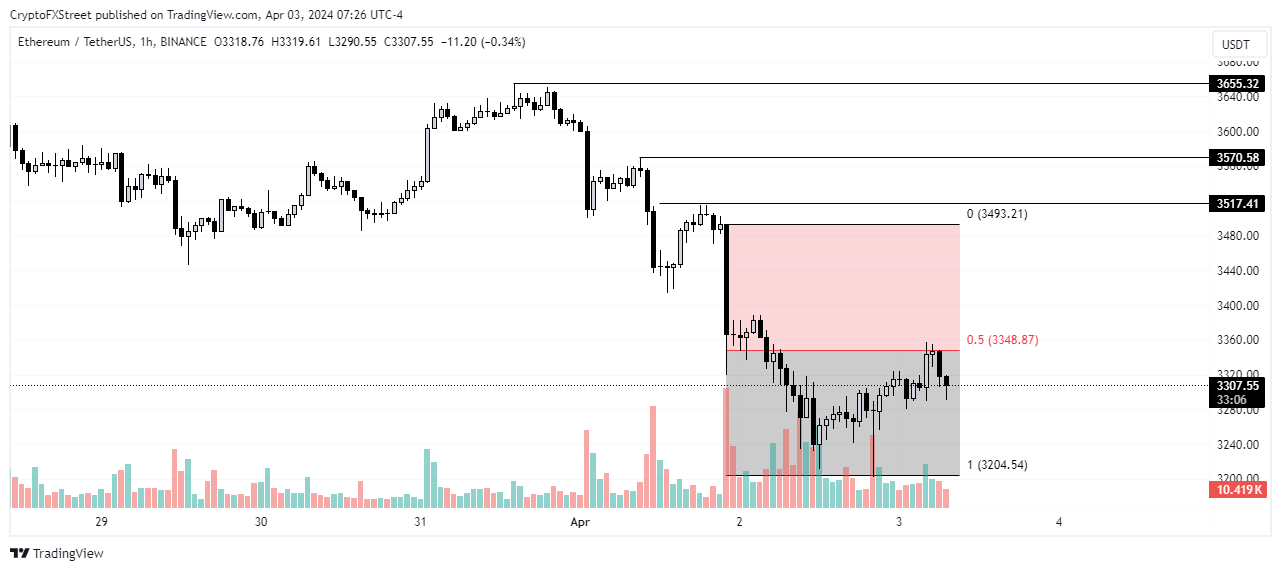- Ethereum’s price has been consolidating since the recent crypto market correction weakened the bullish sentiments of traders.
- Coinbase analysts have warned of the risks that restaking protocols carry.
- Ethereum Foundation developers have been the target of criticism after a recent article on ETH’s issuance curve.
Ethereum’s price has been consolidating on Wednesday following its recent crash. The recent price movement follows Coinbase analysts raising concerns about “hidden risks” in restaking protocols and criticism labeled at the Ethereum Foundation after an article recommending adjustments to the ETH issuance curve.
Also read: Ethereum drops further as Bitcoin’s decline, uncertainty over ETF weigh
Daily digest market movers: Coinbase says restaking introduces risks to Ethereum amid criticisms at developers
Ethereum (ETH) has seen over $84 million in liquidations in the past 24 hours. As ETH price cools off, several interesting factors are playing out within its ecosystem:
- Coinbase analysts David Duong and David Han highlighted the hidden risks in liquid restaking protocols and their tokens in a research report released on April 2. These protocols became popular following the launch of the Eigenlayer restaking protocol on Ethereum.
- Eigenlayer allows protocols to maximize yields through a restaking process where users receive extra yields in liquid restaking tokens (LRTs) for restaking the derivative tokens they earned from staking Ethereum in protocols like Lido Finance. This is similar to repurposing collateral from a DeFi loan to earn extra yields on other protocols.
- The analysts warned that while leveraging staked tokens in several protocols at the same time earns good yields, “it can also compound risks” from a financial and security perspective. They noted that pursuing capital efficiency may expose restakers to high risk. “LRTs may be incentivized to maximize their yields to gain market share, but these could come at the cost of a higher (albeit hidden) risk profile,” Coinbase analysts said.
- The analysts also noted that LRT DAOs may expose themselves to too many risks as the restaking structure incentivizes them to “maximally restake multiple times to remain competitive.” This follows a jump in the total value locked (TVL) of restaking protocols like Etherfi, Renzo, Kelp, etc.
- Some members of the crypto community have also labeled criticisms at Ethereum developers after a recent document published on March 30 by Ethereum Foundation researcher Michael Neuder proposed a change in the issuance curve of the largest altcoin.
- Eric Conner, co-author of the Ethereum Improvement Proposal 1559 (EIP-1559), said in an X post on March 30, “The current push to tweak it is a completely over reaction to centralization concerns that are unfounded.” He added, “I’ll fight this idea with anything I have.”
- Another X user made similar remarks voicing against Ethereum’s monetary policy being tampered every year. Meanwhile, community member @post_polar_ also took to X, saying Ethereum developers appear to have “an outsized power” and aren’t engaging “the wider set of stakeholders.” However, Ethereum developer Tim Beiko responded to his criticism in another X post saying that this polemic is engaging.
- The US Security and Exchange Commission (SEC) filed Fidelity’s Ethereum ETF application on Tuesday but Bloomberg analyst James Seyffart said in an X post that this doesn’t improve the odds of an approval. He also mentioned that “silence from the SEC isn’t a good thing.”
Technical analysis: ETH bulls show weak hands
Ethereum price is yet to recover losses incurred from its sharp decline on Monday. Current price movements indicate uncertainty after the decline weakened bullish sentiments.
However, ETH could rise to around $3,493 to fill up liquidity voids from Monday’s sharp decline. If Bitcoin’s price also recovers, ETH’s price could resume bullish momentum and target $3,517.42, $3,570.58, and $3,655.32.

ETH/USDT 1-hour chart
Also read: US Dollar strength could be one of the reasons why Bitcoin could crash more
This thesis would be invalidated if the bears prevail to send its price below the $3,204.54 support.
Ethereum development FAQs
After the Merge, the Ethereum community is looking at the Sharding upgrade next, which has been slated for sometime later in the year. The development can be summarized in four words, “scalability through more efficient data storage.” The software update will increase the capacity of the blockchain, widening the amount of data that can be stored or accessed. At the same time, all services running atop the Ethereum blockchain will enjoy significantly reduced transaction fees.
A fork is the splitting of a blockchain after developers agree and proceed to implement upgrades. The decision comes after these developers reach a consensus for a software upgrade. The ensuing part will see one part continue with the status as is, while the other one will proceed with new features combined with the former ones. A hard fork basically entails permanent divergence of a new side chain from the original one, while a soft fork is doing the same, only difference being that it is temporary.
EIP-4844 is an improvement proposal for the Ethereum network. The upgrade promises reduced gas fees, which is a valuable offering considering the high transaction cost that continues to daunt crypto players. It has been a long-standing concern for the Ethereum network. The proposal is also referred to as “proto-Danksharding,” with an unmatched ability to increase the speed of transactions on the Ethereum blockchain. At the same time, it helps to reduce the transaction cost as everything becomes decentralized.
Gas token is a new, innovative Ethereum contract where users can tokenize gas on the Ethereum network. This means they can store gas when it is cheap and start to deploy the gas once the market has shifted to the north. The use of Gas token helps to subsidize high gas prices on transactions, meaning investors can do everything from arbitraging decentralized exchanges to buying into initial coin offerings (ICOs) early.

























